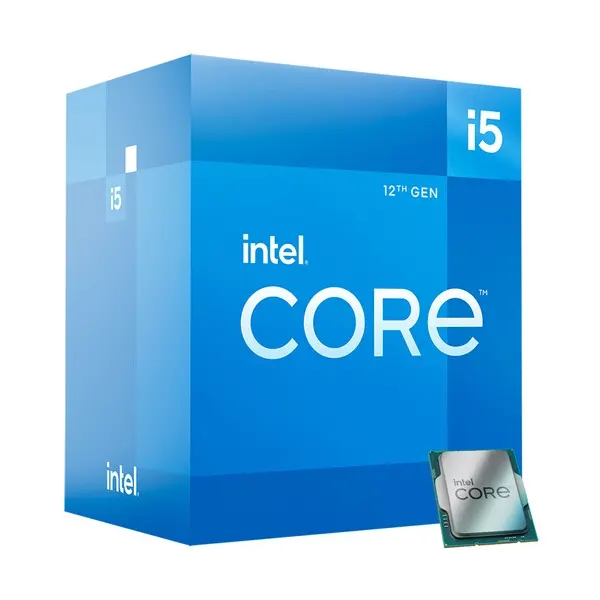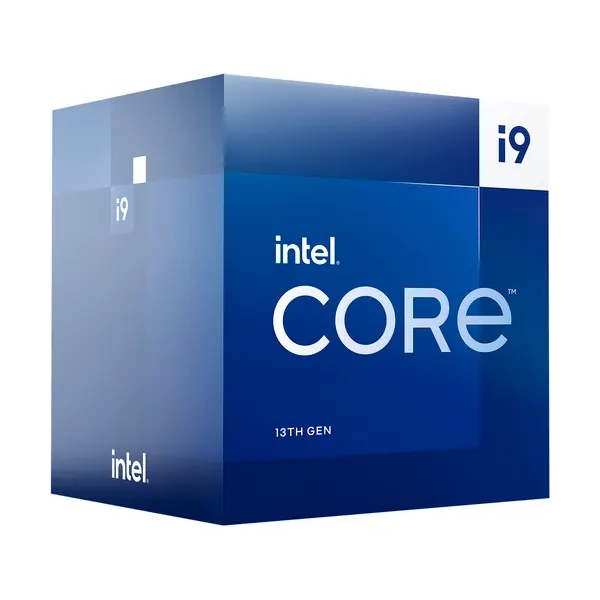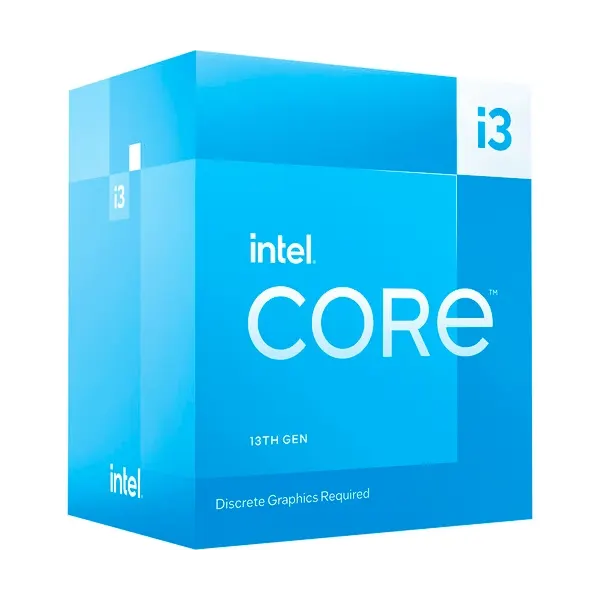Intel Core i5-13600KF Processor in UAE
Power up your productivity, gaming, and content creation with the Intel Core i5-13600KF 3.5 GHz 14-Core LGA 1700 Processor. This 13th generation desktop processor builds upon the Hybrid Core architecture and Intel 7 process by fitting 14 cores— four more than the previous generation— onto a single processor while still supporting the LGA 1700 socket. Designed to provide strong performance for everyday tasks, the Core i5-13600KF features eight low-voltage Efficient-cores that handle background tasks for multitasking while the six 3.5 GHz Performance-cores power applications and games. The built-in Intel Thread Director ensures that the two work seamlessly together by dynamically and intelligently assigning workloads to the right core at the right time.

Intel Core i5-13600KF Processor Gallery
Unparalleled Design, Blazing Performance, your true PC partner.
Now another important feature among them is their supporting capability. It also provides PCI-Express Gen 5 connection for easy communication with other components in the machine itself.




Specifications
Furthermore, this processor has 20 lanes total for outstanding data throughput with compatible devices, supporting up to four PCIe 4.0 and sixteen PCIe 5.0 lanes. Intel Core i5-13600KF in UAE uses Gaussian and Neural Accelerator 3.0 (GNA) technology. Additionally, it enhances backdrop blur in video chats while reducing noise.
| Product Collection | 13th Generation Intel® Core™ i5 Processors |
| Code Name | Products formerly Raptor Lake |
| Vertical Segment | Desktop |
| Processor Number
The Intel processor number is just one of several factors—along with processor
brand, system
configurations, and system-level benchmarks—to be considered when choosing the right
processor for
your computing needs. Read more about interpreting
Intel®
processor numbers or Intel®
processor numbers for the Data Center.
|
i5-13600KF |
| Status | Launched |
| Launch Date
The date the product was first introduced.
|
Q4'22 |
| Lithography Lithography refers to the semiconductor technology used to
manufacture an
integrated circuit, and is reported in nanometer (nm), indicative of the size of
features built on the
semiconductor.
|
Intel 7 |
| Use Conditions
Use conditions are the environmental and operating conditions derived from the
context of system use.
For SKU specific use condition information, see
PRQ report .
For current use condition information, see
Intel UC (CNDA site)*.
|
PC/Client/Tablet, Workstation |
| Recommended Customer Price
Recommended Customer Price (RCP) is pricing guidance only for Intel
products. Prices
are for direct Intel customers, usually represent 1,000-unit purchase quantities,
and are subject to
change without notice. Prices may vary for other package types and shipment
quantities. In bulk, price
represents individual unit. Listing of RCP does not constitute a formal pricing
offer from Intel.
|
$294.00 - $304.00 |
| CPU Specifications | |
|---|---|
| Total Cores
Cores is a hardware term that describes the number of independent
central processing
units in a single computing component (die or chip).
|
14 |
| # of Performance-cores | 6 |
| # of Efficient-cores | 8 |
| Total Threads
Where applicable, Intel® Hyper-Threading Technology is only available
on
Performance-cores.
|
20 |
| Max Turbo Frequency
Max Turbo Frequency is the maximum single-core frequency at which the
processor is
capable of operating using Intel® Turbo Boost Technology and, if present, Intel®
Turbo Boost Max
Technology 3.0 and Intel® Thermal Velocity Boost. Frequency is typically measured in
gigahertz (GHz),
or billion cycles per second.
|
5.10 GHz |
| Performance-core Max Turbo Frequency Maximum P-core turbo frequency
derived from
Intel® Turbo Boost Technology.
|
5.10 GHz |
| Efficient-core Max Turbo Frequency Maximum E-core turbo frequency
derived from Intel®
Turbo Boost Technology.
|
3.90 GHz |
| Performance-core Base Frequency | 3.50 GHz |
| Efficient-core Base Frequency | 2.60 GHz |
| Cache CPU Cache is an area of fast memory located on the processor.
Intel® Smart
Cache
refers to the architecture that allows all cores to dynamically share access to the
last level cache.
|
24 MB Intel® Smart Cache |
| Total L2 Cache | 20 MB |
| Processor Base Power The time-averaged power dissipation that the
processor is
validated
to not exceed during manufacturing while executing an Intel-specified high
complexity workload at Base
Frequency and at the junction temperature as specified in the Datasheet for the SKU
segment and
configuration.
|
125 W |
| Maximum Turbo Power The maximum sustained (>1s) power dissipation of
the processor
as
limited by current and/or temperature controls. Instantaneous power may exceed
Maximum Turbo Power for
short durations (<=10ms). Note: Maximum Turbo Power is configurable by system vendor and can be system
specific.
|
181 W |
| Supplemental Information | |
| Embedded Options Available Embedded Options Available indicates
products that offer
extended purchase availability for intelligent systems and embedded solutions.
Product certification
and use condition applications can be found in the Production Release Qualification
(PRQ) report. See
your Intel representative for details.
|
No |
| Memory Specifications | |
| Max Memory Size (dependent on memory type) Max memory size refers to
the maximum
memory capacity supported by the processor.
|
128 GB |
| Memory Types Intel® processors come in four different types: Single
Channel, Dual
Channel, Triple Channel, and Flex Mode. Maximum supported memory speed may be lower
when populating
multiple DIMMs per channel on products that support multiple memory channels.
|
Up to DDR5 5600 MT/s Up to DDR4 3200 MT/s |
| Max # of Memory Channels The number of memory channels refers to the
bandwidth
operation for real world application.
|
2 |
| Max Memory Bandwidth Max Memory bandwidth is the maximum rate at which
data can be
read from or stored into a semiconductor memory by the processor (in GB/s).
|
89.6 GB/s |
| Expansion Options | |
| Direct Media Interface (DMI) Revision | 4.0 |
| Max # of DMI Lanes | 8 |
| Scalability | 1S Only |
| PCI Express Revision PCI Express Revision is the supported version of
the PCI Express
standard. Peripheral Component Interconnect Express (or PCIe) is a high-speed serial
computer
expansion bus standard for attaching hardware devices to a computer. The different
PCI Express
versions support different data rates.
|
5.0 and 4.0 |
| PCI Express Configurations PCI Express (PCIe) Configurations describe
the available
PCIe lane configurations that can be used to link to PCIe devices.
|
Up to 1x16+4, 2x8+4 |
| Max # of PCI Express Lanes A PCI Express (PCIe) lane consists of two
differential
signaling pairs, one for receiving data, one for transmitting data, and is the basic
unit of the PCIe
bus. Max # of PCI Express Lanes is the total number of supported lanes.
|
20 |
| Package Specifications | |
| Sockets Supported The socket is the component that provides the
mechanical and
electrical connections between the processor and motherboard.
|
FCLGA1700 |
| Max CPU Configuration | 1 |
| T-JUNCTION Junction Temperature is the maximum temperature allowed at
the processor
die.
|
100°C |
| Advanced Technologies | |
| Intel® Gaussian & Neural Accelerator Intel® Gaussian & Neural
Accelerator (GNA) is an
ultra-low power accelerator block designed to run audio and speed-centric AI
workloads. Intel® GNA is
designed to run audio based neural networks at ultra-low power, while simultaneously
relieving the CPU
of this workload.
|
3.0 |
| Intel® Thread Director | Yes |
| Intel® Deep Learning Boost (Intel® DL Boost) A new set of embedded
processor
technologies designed to accelerate AI deep learning use cases. It extends Intel
AVX-512 with a new
Vector Neural Network Instruction (VNNI) that significantly increases deep learning
inference
performance over previous generations.
|
Yes |
| Intel® Speed Shift Technology Intel® Speed Shift Technology uses
hardware-controlled
P-states to deliver dramatically quicker responsiveness with single-threaded,
transient (short
duration) workloads, such as web browsing, by allowing the processor to more quickly
select its best
operating frequency and voltage for optimal performance and power efficiency.
|
Yes |
| Intel® Turbo Boost Max Technology 3.0 Intel® Turbo Boost Max Technology
3.0
identifies the best performing core(s) on a processor and provides increased
performance on those
cores through increasing frequency as needed by taking advantage of power and
thermal headroom.
|
No |
| Intel® Turbo Boost Technology Intel® Turbo Boost Technology dynamically
increases the
processor's frequency as needed by taking advantage of thermal and power headroom to
give you a burst
of speed when you need it, and increased energy efficiency when you don’t.
|
2.0 |
| Intel® Hyper-Threading Technology Intel® Hyper-Threading Technology
(Intel® HT
Technology) delivers two processing threads per physical core. Highly threaded
applications can get
more work done in parallel, completing tasks sooner.
|
Yes |
| Intel® 64 Intel® 64 architecture delivers 64-bit computing on server,
workstation,
desktop and mobile platforms when combined with supporting software.¹ Intel 64
architecture improves
performance by allowing systems to address more than 4 GB of both virtual and
physical memory.
|
Yes |
| Instruction Set An instruction set refers to the basic set of commands
and
instructions that a microprocessor understands and can carry out. The value shown
represents which
Intel’s instruction set this processor is compatible with.
|
64-bit |
| Instruction Set Extensions Instruction Set Extensions are additional
instructions
which can increase performance when the same operations are performed on multiple
data objects. These
can include SSE (Streaming SIMD Extensions) and AVX (Advanced Vector Extensions).
|
Intel® SSE4.1, Intel® SSE4.2, Intel® AVX2 |
| Idle States Idle States (C-states) are used to save power when the
processor is
idle. C0 is the operational state, meaning that the CPU is doing useful work. C1 is
the first idle
state, C2 the second, and so on, where more power saving actions are taken for
numerically higher
C-states.
|
Yes |
| Enhanced Intel SpeedStep® Technology Enhanced Intel SpeedStep®
Technology is an
advanced means of enabling high performance while meeting the power-conservation
needs of mobile
systems. Conventional Intel SpeedStep® Technology switches both voltage and
frequency in tandem
between high and low levels in response to processor load. Enhanced Intel SpeedStep®
Technology builds
upon that architecture using design strategies such as Separation between Voltage
and Frequency
Changes, and Clock Partitioning and Recovery.
|
Yes |
| Thermal Monitoring Technologies Thermal Monitoring Technologies protect
the processor
package and the system from thermal failure through several thermal management
features. An on-die
Digital Thermal Sensor (DTS) detects the core's temperature, and the thermal
management features
reduce package power consumption and thereby temperature when required in order to
remain within
normal operating limits.
|
Yes |
| Intel® Volume Management Device (VMD) Intel® Volume Management Device
(VMD) provides
a common, robust method of hot plug and LED management for NVMe-based solid state
drives.
|
Yes |
| Security & Reliability | |
| Intel® Standard Manageability (ISM) Intel® Standard Manageability is
the
manageability solution for Intel vPro® Essentials platforms and is a subset of
Intel® AMT with
out-of-band management over Ethernet and Wi-Fi, but no KVM or new life cycle
management features.
|
Yes |
| Intel® Control-Flow Enforcement Technology CET - Intel Control-flow
Enforcement
Technology (CET) helps protect against the misuse of legitimate code snippets
through return-oriented
programming (ROP) control-flow hijacking attacks.
|
Yes |
| Intel® AES New Instructions Intel® AES New Instructions (Intel® AES-NI)
are a set of
instructions that enable fast and secure data encryption and decryption. AES-NI are
valuable for a
wide range of cryptographic applications, for example: applications that perform
bulk
encryption/decryption, authentication, random number generation, and authenticated
encryption.
|
Yes |
| Secure Key Intel® Secure Key consists of a digital random number
generator that
creates truly random numbers to strengthen encryption algorithms.
|
Yes |
| Intel® OS Guard | Yes |
| Execute Disable Bit Execute Disable Bit is a hardware-based security
feature that can
reduce exposure to viruses and malicious-code attacks and prevent harmful software
from executing and
propagating on the server or network.
|
Yes |
| Intel® Boot Guard Intel® Device Protection Technology with Boot Guard
helps protect
the system’s pre-OS environment from viruses and malicious software attacks.
|
Yes |
| Secure Key Intel® Secure Key consists of a digital random number
generator that
creates truly random numbers to strengthen encryption algorithms.
|
Yes |
| Intel® OS Guard | Yes |
| Execute Disable Bit Execute Disable Bit is a hardware-based security
feature that
can reduce exposure to viruses and malicious-code attacks and prevent harmful
software from executing
and propagating on the server or network.
|
Yes |
| Intel® Boot Guard Intel® Device Protection Technology with Boot Guard
helps protect
the system’s pre-OS environment from viruses and malicious software attacks.
|
Yes |
| Mode-based Execute Control (MBEC) Mode-based Execute Control can more
reliably verify
and enforce the integrity of kernel level code.
|
Yes |
| Intel® Virtualization Technology (VT-x) Intel® Virtualization
Technology (VT-x)
allows one hardware platform to function as multiple “virtual” platforms. It offers
improved
manageability by limiting downtime and maintaining productivity by isolating
computing activities into
separate partitions.
|
Yes |
| Intel® Virtualization Technology (VT-x) Intel® Virtualization
Technology (VT-x)
allows one hardware platform to function as multiple “virtual” platforms. It offers
improved
manageability by limiting downtime and maintaining productivity by isolating
computing activities into
separate partitions.
|
Yes |
| Intel® Virtualization Technology for Directed I/O (VT-d) Intel®
Virtualization
Technology for Directed I/O (VT-d) continues from the existing support for IA-32
(VT-x) and Itanium®
processor (VT-i) virtualization adding new support for I/O-device virtualization.
Intel VT-d can help
end users improve security and reliability of the systems and also improve
performance of I/O devices
in virtualized environments.
|
Yes |
| Intel® VT-x with Extended Page Tables (EPT) Intel® VT-x with Extended
Page Tables
(EPT), also known as Second Level Address Translation (SLAT), provides acceleration
for memory
intensive virtualized applications. Extended Page Tables in Intel® Virtualization
Technology platforms
reduces the memory and power overhead costs and increases battery life through
hardware optimization
of page table management.
|
Yes |
Similar Products
FAQ (Frequently Asked Questions)
Is Intel Core i5-13600KF a good processor?
These are useful for a better gaming experience and faster processing. Because this processor comes with 14 cores and 02 threads at a price that is affordable for any user.
How about Intel Core i5-13600KF Performance?
Intel i5-13600KF Processor has 6- Performance Cores and 8- Efficient Cores, while the 12600KF has only 6 P-cores and 4 E-cores and i5-13600KF also comes with more threads compared to i9-12600KF.
Is Intel Core i5-13600KF Good for Gaming?
Yes, of course. Intel i5-13600KF processor's L2 cache memory and processor graphics give you another level of experience in gaming.
Does Intel Core i5-13600KF have graphics?
No, Intel i5-13600KF doesn't provided any graphics card.
How much is the best price of the 13600KF in UAE?
With 12 Months installments 103.17 AED for each Month or 1,238.00 AED/- Total Amount




